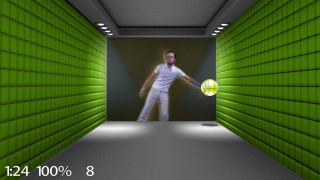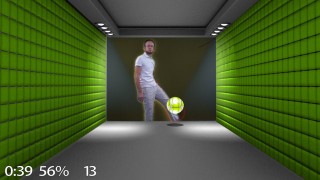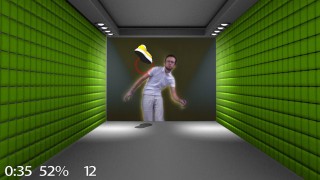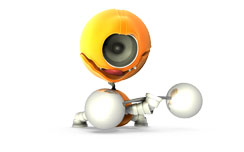
 |
 |
 |
BRIEF DESCRIPTION
In the game Ball the patient has to deflect virtual balls flying towards her/him from various directions. The therapist can introduce negative stimuli into the game. The negative stimuli takes the form of virtual flying shoes which the patient has to dodge. The amount and velocity of the objects flying towards the patient are controlled by the therapist. During this exercise the patient sees the mirror image of her/himself in the screen.
RECOMMENDATIONS AND POSSIBILITIES
Recommended to patients with musculoskeletal dysfunctions of upper and lower limbs, as well as to patients with neurological disorders. The objectives of the module are to increase the range of movements, improve visual-motor coordination, develop the ability of predicting trajectory of objects in motion in 3-dimensional space, strengthen certain muscles, and exercise the injured upper limb with or without the support of the healthy one. During the exercise the patient sees the mirror image of her-/himself in the screen. The exercise consists in reacting immediately to stimuli that appear in a certain rhythm. The patient performs movements in all planes of motion and receives immediate visual and acoustic feedback.
PATIENT REQUIREMENTS
The patient can perform the exercise either sitting or standing. The exercise is very intuitive and do not require any special abilities of the patient. It can also be performed by patients with limb amputations.
TASKS
The patient’s task is to deflect the balls which fly towards her/him, like a volleyball player or goalkeeper. The image of the patient is placed in the center of the screen and the balls are thrown against the patient. Her/his task is to evaluate the distance of a ball flying toward her/him and to block it in the right moment. The patient also has to dodge the shoes that fly toward her/him. In order to do that the patient has to be able to differentiate between the balls and shoes and decide how to behave in relation to these objects.
DIFFICULTY LEVELS
The difficulty of the exercise depends on the arrangement of the exercise parameters. The therapist can modify the target area and the velocity of the balls. The negative stimuli are also controlled by the therapist – s/he decides whether to introduce it and modifies its frequency of appearance. The therapist can also choose which parts of the patient’s body will be used to deflect the balls. What is more, if the patient has problems with predicting the trajectory of the ball, it is possible to add special markers which show the patient the target area of the flying ball.
DATA AND REPORTS
The module saves data concerning the level of correctness in performing the exercise, the level of the patient’s physical activity during the exercise, and the range of the upper limb movements. The module also reports the number of appropriate and inappropriate responses to positive and negative stimuli.
HINTS AND TIPS
When the patient cannot properly evaluate the distance between her/him and the ball, or the target of the ball, s/he uses her/his body to control as big part of the target area as possible. This makes the patient more engaged in the exercise and causes him/her to move a lot, which is good for her/him. The therapist may try to use this situation for the greater benefit of the patient.
More information


This is a modern approach to rehabilitation, which is fun for the patient. This form of a session, from the psychological point of view, brings many positive aspects, which result in stronger effects - desired in terms of improving the functioning of the people undergoing the rehabilitation. Find more Kinect Rehabilitation




